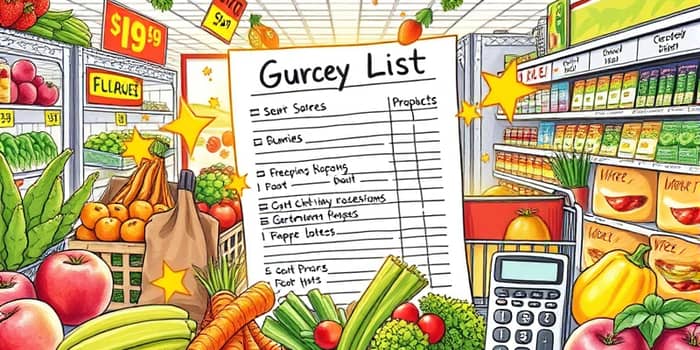Transforming your grocery routine into a cost-saving powerhouse starts with a strategic shopping list. By embracing planning, tracking, and smart purchasing, you can unlock significant monthly and yearly savings without sacrificing quality or nutrition.
Why a Shopping List is Your Money-Saving Weapon
In today’s busy world, impulse buys and extra store trips add up quickly. Studies show that using a strategic shopping list can yield estimated savings of $150 per month, totaling nearly $2,000 a year in one real-world case. Lists help you avoid impulse purchases, reduce food waste, and streamline your shopping trips.
With a clear list in hand, you’re less likely to get sidetracked by flashy deals or run into the store mid-week for forgotten items. This simple tool can become a cornerstone of your household budget.
Getting Started: Preparation and Tracking
- Track Your Spending: Record all grocery and household expenses in a spreadsheet or app to spot trends.
- Review Receipts: maintain a price comparison spreadsheet to learn sale cycles and best store values.
- Set a Budget: Establish a weekly or monthly grocery limit based on your financial goals.
- Plan Meals: Build your list around a weekly menu to ensure you buy only what you’ll use.
By laying this groundwork, you’ll understand your habits, avoid budget surprises, and tailor your list to real needs rather than whims.
Core Elements of a Money-Saving Shopping List
Creating a list that delivers real savings requires organization and discipline. Structure your list by store department or aisle—this prevents wandering and avoid extra mid-week trips to the store that often lead to overspending.
- Precise Quantities: Use your meal plan to note exact amounts, minimizing spoilage.
- Highlight Deals: Identify sale items with brand and sale price, and plan your meals around those specials.
- Selective Stock-Up: Stock items with a long shelf life when they’re discounted, but only if you use them regularly.
- Brand Flexibility: Opt for store or private-label brands for staples to cut costs without sacrificing quality.
- Coupon Discipline: Clip only coupons for items you need to prevent unnecessary spending.
- Generic & Frozen Options: Buy generic staples and frozen produce to extend freshness and save money.
This structured approach turns a simple list into a powerful budget tool, ensuring you buy smarter and waste less.
Behavioral Hacks and Advanced Techniques
Beyond the basics, small behavioral changes can boost your savings even further. Shop midweek to catch markdowns and avoid crowds. Use loyalty programs and digital coupons to stack discounts. Paying with a rewards credit card—if you pay the balance in full each month—can net you 1–6% cashback on grocery purchases.
Adopt the rule: if it’s not on the list, it doesn’t go in the cart. This simple nudge combats impulse buys and reinforces disciplined shopping. Packing snacks and lunches from bulk purchases also steers you away from premium-priced convenience items.
For long-term staples, consider subscription orders that often come at a discount. And don’t forget to document sales cycles over time, using past receipts to recognize true bargains versus fleeting promotions.
Case Study: A Family’s Real Savings
The Johnson family decided to overhaul their grocery routine. By tracking expenses for a month, planning meals in advance, and following a structured list, they slashed their grocery bill from $650 to $500 per month.
In total, they saved nearly $2,900 in one year—enough to fund a family vacation or pad their emergency fund.
Common Pitfalls to Avoid
Even the best intentions can go awry if you fall into these traps:
- Buying items just because there’s a coupon, even if you don’t need them.
- Overbuying perishables in bulk, leading to waste and higher costs.
- Shopping hungry or without a list, which invites impulse purchases.
- Ignoring loyalty programs, reward points, or cashback opportunities.
- Failing to update your price book, missing out on genuine deals.
Tools, Apps, and Templates
Modern tools make list-making effortless. Apps like AnyList, Out of Milk, or customized spreadsheet templates help you track prices, organize departments, and share lists with family members. Printable templates are also widely available to keep you on track, whether you prefer pen and paper or digital convenience.
Set clear rules—such as color-coding sale items or highlighting stock-up products—to further streamline your process. Integrate meal-planning calendars directly into your list app for seamless coordination between recipes and shopping.
Quick Win Checklist
- Set a strict weekly grocery budget and stick to it.
- Plan meals around sale items and seasonal produce.
- Use store maps or department lists to shop efficiently.
- Employ one rewards credit card for all grocery purchases.
- Review and update your price book monthly.
By following these steps, you’ll build a robust, money-saving shopping list that delivers real results. Over time, these small habits compound into thousands of dollars saved—helping you achieve financial goals faster and enjoy peace of mind in your grocery routine.
References
- https://thedinnerdaily.com/saving-money-on-groceries-how-i-saved-347-in-one-month/
- https://www.nerdwallet.com/article/finance/ways-to-save-money-on-food-groceries
- https://www.goodhousekeeping.com/health/diet-nutrition/a40619434/cheap-groceries-list/
- https://www.amenify.com/blog/time-saving-tips-for-grocery-shopping-with-amenify
- https://zenhabits.net/50-tips-for-grocery-shopping/
- https://bettermoneyhabits.bankofamerica.com/en/saving-budgeting/ways-to-save-money
- https://www.youtube.com/watch?v=psnBdgj0Q4c
- https://thecreativeindependent.com/guides/how-to-write-a-book-proposal/










